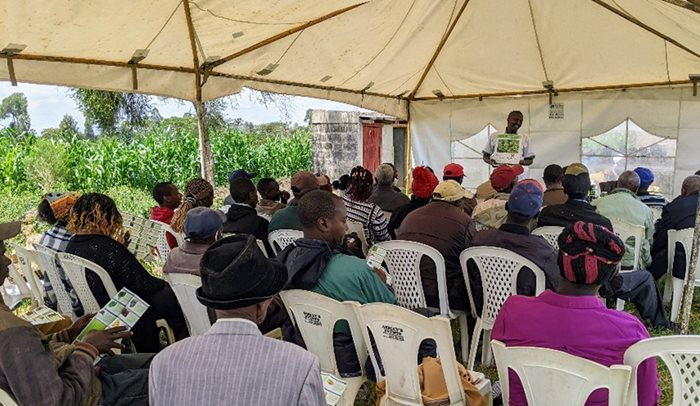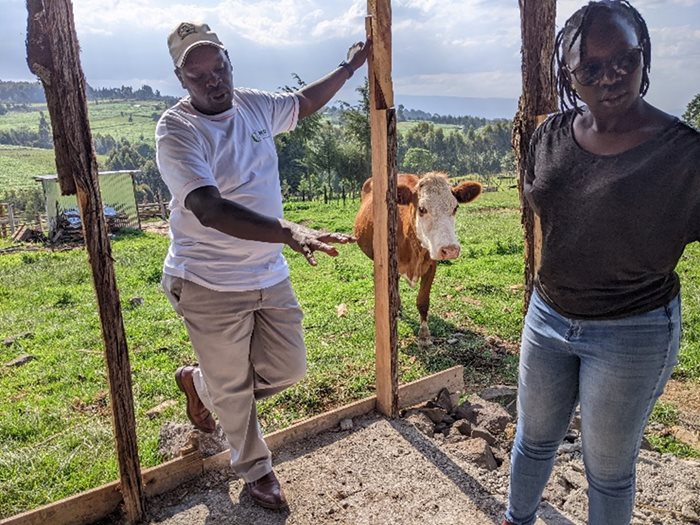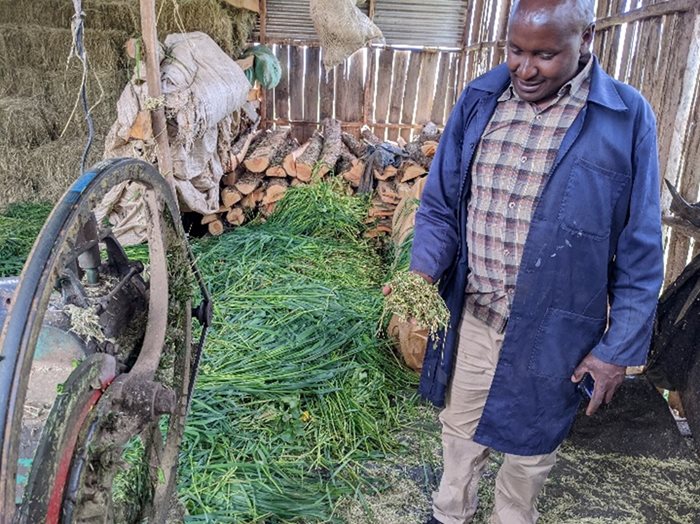The Kenya Nourishing Prosperity Alliance, in a groundbreaking private sector-led initiative, targets animal nutrition and local forage markets as the key to transforming livestock systems. A climate-smart approach boosts resiliency for smallholder dairy livelihoods and enhances local access to nutritious animal-sourced foods.
Banner image: Weighing forage sorghum in Machakos country, with the help of ILRI staff.
Kenya’s dairy sector is an important part of the economy, making up 3.5 percent of the country’s total GDP and employing over two million households, according to an
FAO report as of 2017. Yet livestock productivity remains relatively low, due in part to poor nutrition caused by high feeding costs, low quality fodder on the market, and seasonal variability of forages, according to a 2018 dairy value chain assessment
report by the International Livestock Research Institute (ILRI). If more milk could be produced by each cow through improved nutrition, it would increase local milk supply, raise revenues for smallholder dairy farmers and reduce emissions intensity from the livestock sector. The resulting productivity gains would be transformative for local communities.
Recognizing the need to address the gap in forage markets, the Kenya Nourishing Prosperity Alliance (KNPA) was launched in July 2020. Convening private sector, non-profit, and research organizations across the animal nutrition market system, it is implemented by Land O’Lakes Venture37, in partnership with leading multinational firms
Corteva Agriscience and
Forage Genetics International, as well as
ILRI. Venture37’s participation in KNPA is made possible by a grant from Corteva Agriscience.
Through this innovative private sector-led alliance model, KNPA is driving a market-oriented approach to dairy sector development by supporting the growth of demand for forage and increasing the availability of improved forage products. Project components — including engagement with smallholder dairy farmers, forage testing and screening, and forage harvesting and conservation — complement one another to help develop vibrant commercial marketplaces that reliably supply nutritious, high quality, climate-smart forage varietals to smallholder dairy farmers, year-round. Given the potential of this model to transform the forage sector and advance climate mitigation, adaptation, and resilience, the Nourishing Prosperity Alliance has been named an
AIM for Climate Innovation Sprint Partner, an award that was announced at COP27 last November.
Private Sector Engagement with Dairy Farmers
Throughout the stages of forage production, KNPA conducts a series of field day training sessions in collaboration with local agribusinesses to directly engage smallholder dairy farmers. KNPA field staff teach farmers about dairy management and climate-smart forage production, harvesting, and storage. Local and international firms train participants in the appropriate use of products and services such as dairy concentrates, fertilizer, drought-resistant seed varieties, and breed genetics. This training model allows smallholders access not only to the latest climate smart practices and knowledge, but also to high quality inputs that are otherwise difficult to source. To date, over 5,500 smallholder and emerging dairy farmers have been trained, of which 61 percent have gone on to establish improved forage on their farms.
 Local seed supply partner, Kenya Highland Seed Co., talks about lucerne with farmers.
Local seed supply partner, Kenya Highland Seed Co., talks about lucerne with farmers.
In addition to training sessions, KNPA also implements feeding trials to understand the performance of various forage varieties as a source of quality animal nutrition. Of the participating farmers that have already harvested and started using their forage, 87 percent have reported an increase in milk production. Farmer Antoni Kiari Muigai in the Pasenga area is one such farmer that receives guidance on proper rationing for his two cows. As a result, Mr. Muigai noted that his purchases of dairy meal — a cost-intensive commercial feed — were reduced by half. Additionally, since substituting the meal for nutrient-rich forages like lucerne and Napier grass that he grows on his own farm, he has seen an increase in yield from six to 11 liters of milk per cow a day. The quality of milk is also improved, according to Mr. Muigai’s wife, who runs a small cake and coffee shop where she regularly receives compliments on the delicious taste of their farm-fresh milk added to coffee.
On the other side of Lake Nakuru near the town of Elburgon, farmer Johnston Sang also benefits from improved fodder cultivation and feeding practices. Before starting the feeding trials, his cows had a noticeably poor body condition, as the rising cost of commercial hay left Mr. Sang unable to supply them with enough calories. Three seasons later, after swapping low-quality hay for nutrient-dense farm-grown fodder and calculating appropriate feed rations, his cows have filled out to a healthy size, increased daily milk output from ten to over 21 liters per animal a day, and started calving consistently each year. Due to the success of the program, Mr. Sang has rebuilt his stables with a plan to increase his herd size by up to fifteen cows in the future.
Forage Testing and Screening
Forage testing and screening of forage helps the program establish on-the-ground evidence and stay responsive to local conditions. Using ILRI’s Gendered Feed Assessment (G-FEAST) tool, KNPA first conducted a market analysis to screen for existing forage varieties suitable to different agro-ecological zones and farming systems. From there, forage adaptive management sites — known as “Jibu plots” — are established on local farms and then sampled to analyze forage types for nutrient content. The high protein content of lucerne, for example, has contributed to farmer reports that it can serve as a substitute for dairy meal, bringing down overall feeding costs. This and other examples of farmer-led monitoring and innovations to improve varietal quality has allowed extension messaging to be adapted to more local contexts.
 Farmer Johnston Sang and Forage Technician Renny Chemtai discuss adding to Sang's herd, now that he has plenty of farm-grown fodder to feed them.
Farmer Johnston Sang and Forage Technician Renny Chemtai discuss adding to Sang's herd, now that he has plenty of farm-grown fodder to feed them.
Mr. Sang, who is the manager of the Elburgon Progressive Dairy Farmers Cooperative Society, has seen enormous success at the Jibu plots on his farm, growing maize, lucerne, sorghum, and Super Napier grass. In September 2021, he harvested a total of 58 tons of forage maize from two acres of land — which is such an exceptional yield that it had to be confirmed at a truck weigh station. His fields are adjacent to an Elburgon cooperative milk aggregation center — positioning him to showcase the Jibu plots and talk about the improved varieties and practices as farmers come by to drop off their milk. As he learns and adapts to growing conditions on his farm, Mr. Sang feels confident in doubling the amount of land he has dedicated to fodder cultivation in the next season.
Forage Harvesting and Conservation
In times of drought, farmers must increase the amount of cost intensive cut-and-carry fodder to feed their livestock. However, the most widely available forage on the local market is Rhodes grass, which tends to be dry and nutrient-poor. For that reason, KNPA trains emerging commercial farmers in mechanization, harvesting, and conservation to promote year-round availability of forage and greater forage system resilience. Through KNPA activities, farmers can see for themselves that the initial investment for forage establishment is worth its return in milk yield, quality, and consistency. Following the success of the feeding trials, Mr. Muigai plans to increase the amount of land dedicated to lucerne so that he can sell the extra forage to farmers in his area. He will also carry on his training with KNPA to include ensilage, which is a method of conservation that preserves green fodder at its nutritional peak, making nutritious forage available even in dry seasons.
 Farmer Antoni Kiari Muigai holds freshly chopped forage that he grew on his own farm.
Farmer Antoni Kiari Muigai holds freshly chopped forage that he grew on his own farm.
Beyond training sessions, KNPA also facilitates access to mechanization, particularly for fodder choppers that provide the right cut for silage. Contractors through Kenya Cooperative Creameries worked with farmers and cooperatives to process 20 tons of silage over a six-month period. In June 2022, when a month-long drought in the middle of Kenya’s rainy season impacted crops all over the region, cooperatives that provided access to forage choppers continued to collect milk, surpassing yield expectations. Linking smallholders with mechanization and/or commercial farms that have an overabundance of high-quality fodder enables dairy producers of all sizes to benefit from greater income stability, higher market prices, and better resilience to dry periods.
Scaling Impact Through a Market-Oriented Alliance Model
The KNPA approach — targeting improved animal nutrition through forage market linkages — is showing promising results for dairy sector development in Kenya. Interventions that engage smallholder and emerging commercial farmers, test and screen improved forage varieties for local adaptability, and support the use of appropriate practices and technologies for forage conservation, all work together to make forage markets more functional and inclusive of small-scale producers. Moreover, the innovative alliance model allows local and international firms with a shared vision to pre-competitively collaborate to address demand, supply, and enabling environment challenges. As a proof-of-concept pilot project, these early successes point to the potential for scaling the KNPA program, both in Kenya and elsewhere in Africa.